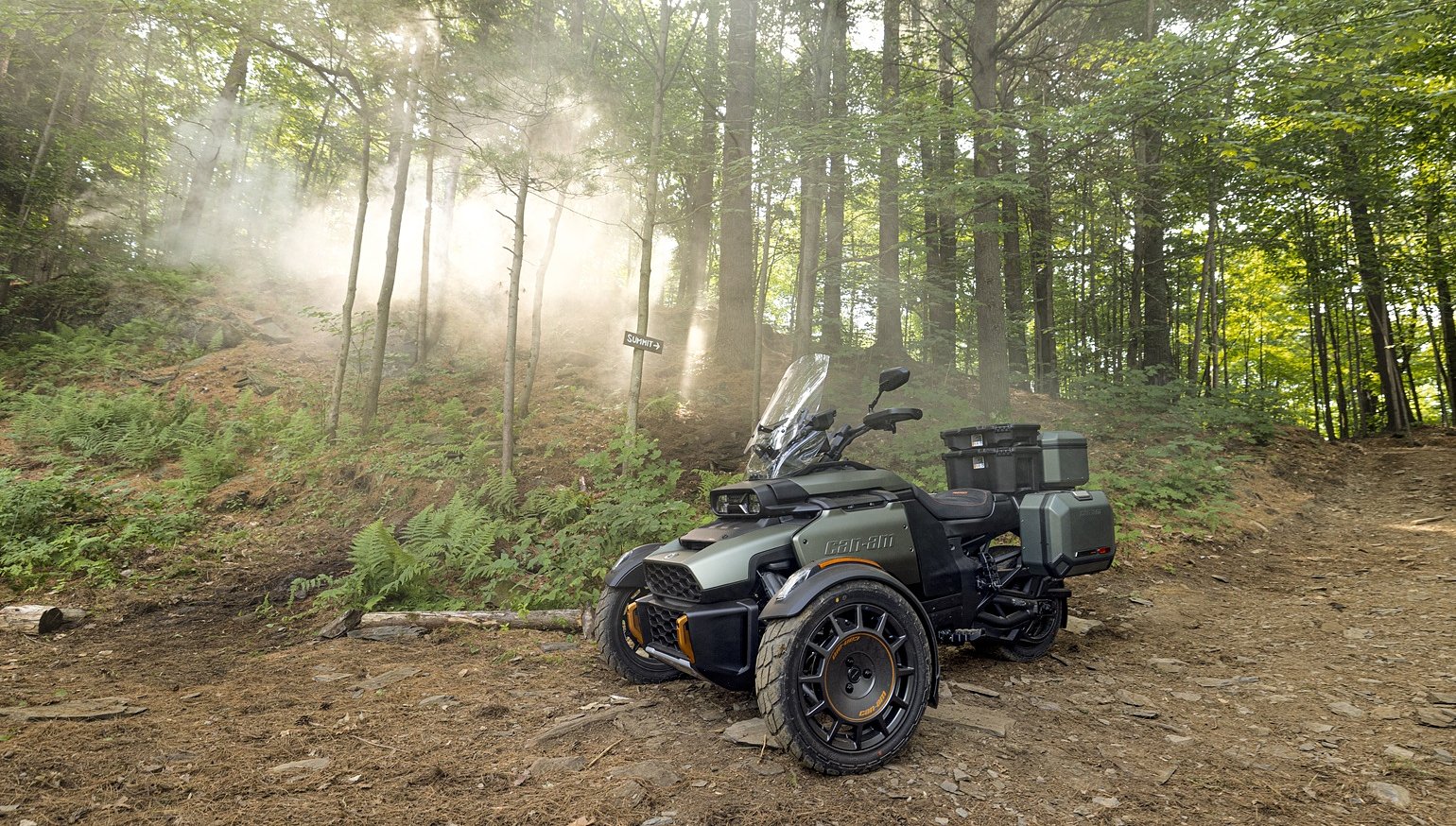There are things with two wheels. There are things with three wheels.
And those two things are not the same at all.
Two-wheeled things can and do fall over during operation. To make a three-wheeled thing fall over is a level of magnitude more challenging, but not impossible.
When everybody's favorite moto-writers — Ari Henning and Zack Courts — published a feature called Adventure trikes: The future of off-road riding?, on July 26, 2024, the question mark in the title really telegraphed the game. Let's just say that there were more than a few "tells" that Ari and Zack's approach to their subject may not have been entirely serious. Despite their willingness to give it a go, clearly, no sensible person would ever attempt such a thing as "adventure triking."
No. Certainly not.
The universe, which also has a reputation for being less than entirely serious itself, tried to set everything back into balance less than three weeks later when Can-Am announced its Canyon three-wheeled adventure machines.
At this monumental display of genuinely unfortunate timing, I did two things in rapid succession. First, I laughed really loud and a lot. And after the deep awkwardness cleared, being a clearly not sensible person, I declared, "I am so going to ride that thing. This is going to be a hoot."
I reached out to Can-Am, and we both agreed it was good idea.
I was stoked. This was going to be a hoot.
My squeeze — Sweet Doris from Baltimore — heard I was getting a Canyon to test.
"A Can-Am three-wheeler? Those things are so much easier to get on and off, compared to your big tourer. Can I come, too? This is going to be a hoot!"
And so, "Adventure Trikes, Real World Edition" was birthed. We'd take the Canyon two-up into Maryland's Green Ridge State Forest — a regionally famous adventure-riding playground — and camp in the most remote spot in the park. At least, that was the plan.
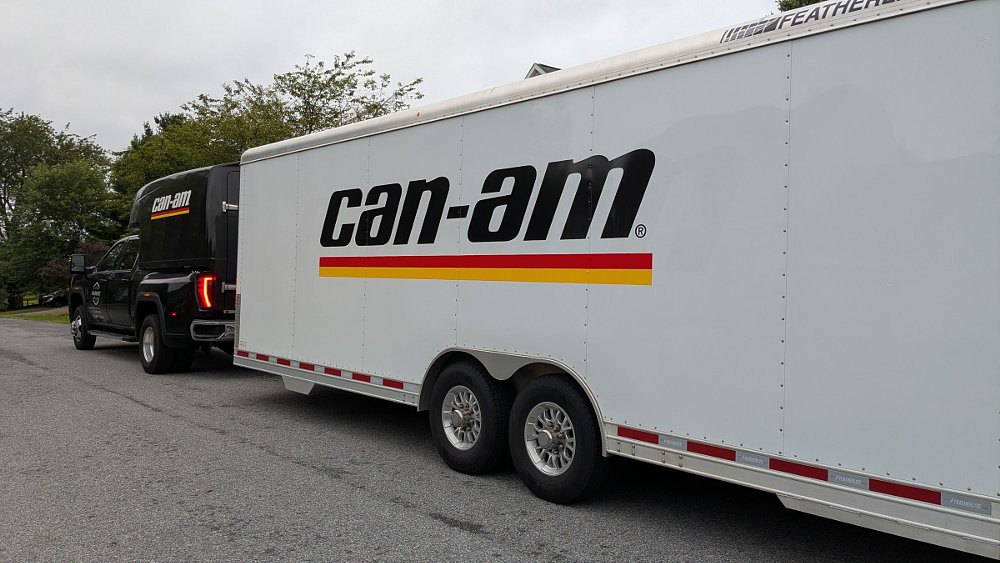
Meet the Canyon
Most motorcycle OEMs use freelance transportation contractors with a van or trailer to deliver test vehicles. When one of the Can-Am Race Team transporters showed up at the end of my driveway, my neighbors were stone impressed.
Once it was off the truck, I had to spend some time drinking in the Canyon to come to grips with it. For starters, the thing is enormous, just over eight feet long and five feet wide at the front wheel track. The provided test machine was a Canyon Redrock — the top-of-the-line trim — that weighs over 1,040 pounds dry. Sitting in my shop next to my turn-of-the-millennium BMW full-dress tourer, the Canyon managed to make my ride look positively dainty.
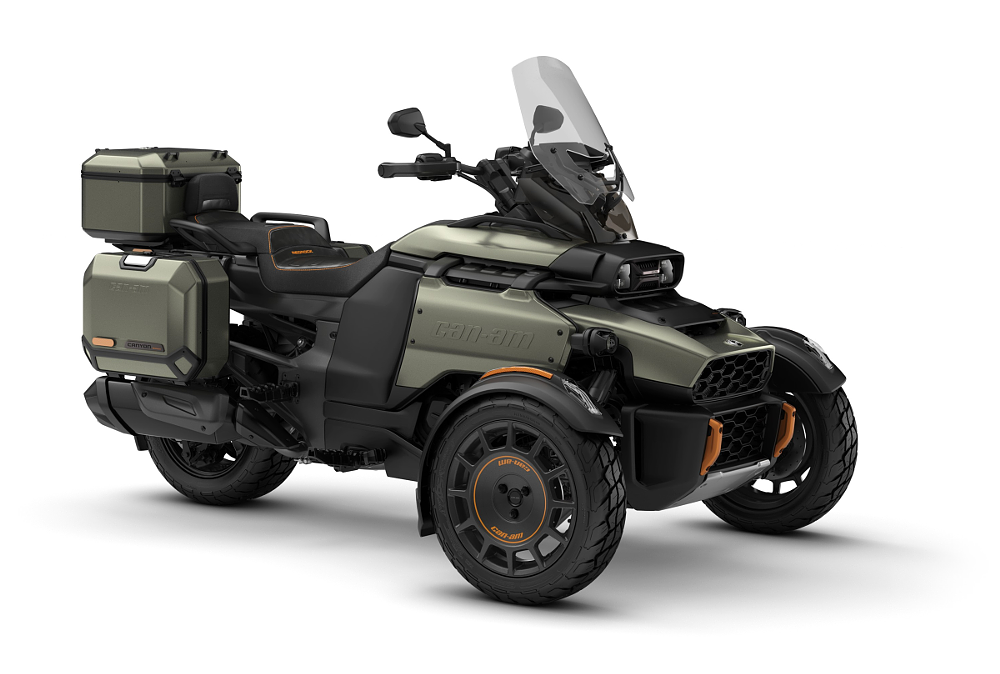
The Canyon's appearance is absolutely arresting. It looks like a cross between a U.S. Army vehicle and something that escaped from the Star Wars universe. The Redrock features a unique grey-green matte colorway and color-matched aluminum expedition cases and top box. The bodywork is defined by straight lines and layered surfaces. The headlamps are tiny LED projector units that define a face on the upper body that resembles a jet intake. A surprising and welcome amount of the engine is visible beneath the bodywork. As I'd find out, my opinion of the machine's appearance was far from unique. Everywhere I took it, I had multiple people wanting to know what it was and telling me how cool they thought it was. It was like what older riders refer to as "Sidecar Syndrome" on steroids.
Mechanically, the Canyon is shoved down the road by a Rotax 1,330 cc DOHC, four-valve, water-cooled, three-cylinder engine producing 115 horsepower and 96 peak foot-pounds of torque. The Canyon will carry 7.1 gallons of premium fuel onboard. I saw just under 200-mile range in the mixed highway and trail usage encountered during the test.
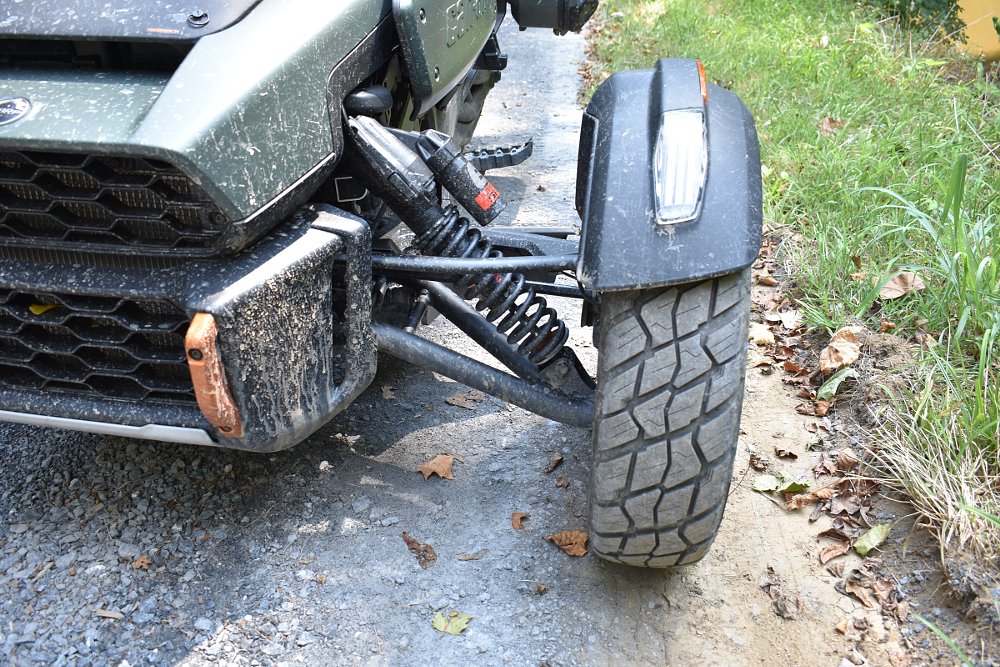
Power is delivered through a unique paddle-shifted semi-automatic transmission. Upshifts are fully rider-controlled using a paddle shifter operated the thumb and forefinger of one's left hand. The Canyon's Transmission Control Module (TCM) will allow the rider to have the machine automatically choose downshifts or override those changes manually from the shift paddle based on preference. There is no clutch lever. All engagement is controlled by the TCM.
Final drive to the rear wheel is via a Kevlar-reinforced belt which features extra shielding for off-pavement use. The belt drives some gnarly looking off-road (dare I suggest "truckish?") tires, custom developed for the Canyon, that sit somewhere between full off-road knobbies and flat-track racing tires. Braking is similarly unique. The front axles have radially mounted four-piston Brembo Monobloc calipers, and the rear has a two-piston Brembo which is modified to work with an electrically applied parking brake. There isn't any brake lever, either. All braking is controlled by a foot pedal on the right footpeg, with brake proportioning and anti-lock behavior handled by the Vehicle Stability System running a customized version of the Bosch Motorcycle Stability Control (MSC) software suite. The Canyon also features electric power steering and the rider can select the level of assist.
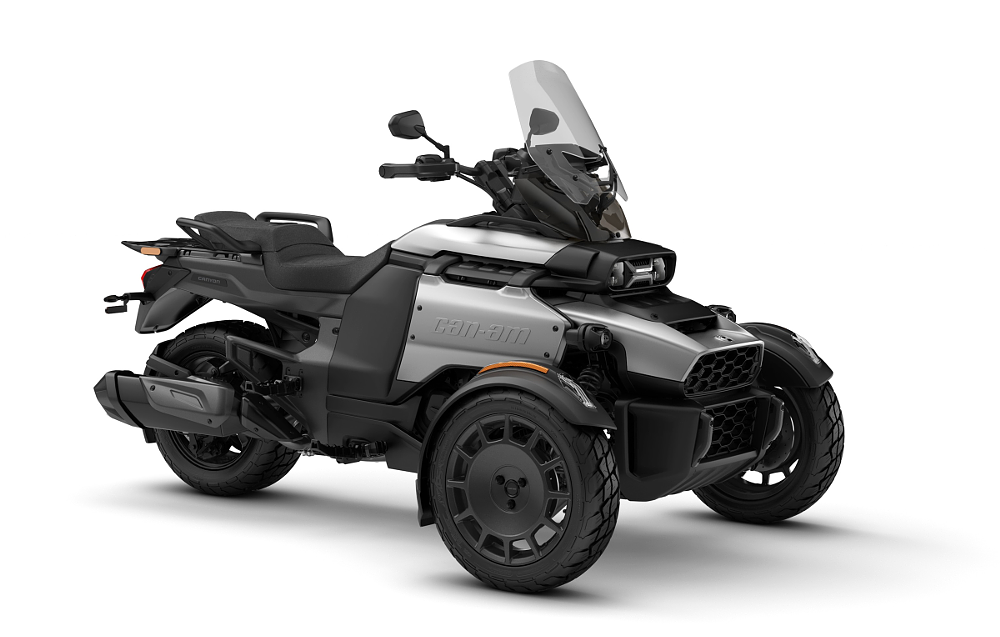
Suspension is where the Canyon differs from the rest of the Can-Am three-wheel line. The Redrock features an automatically preload-adjusting rear KYB Smart-Shox unit. Preload is handled by an onboard compressor, and damping is automatically actively adjusted. Front shocks on the Redrock are also via KYB actively adjusted units, and damping behavior can be adjusted in software to user preference. The Smart-Shox units appear to have been originally developed for Can-Am's higher performance snowmobiles. Lower Canyon trim levels make use of conventional shocks by Sachs. Suspension travel is appropriate for the use case: over nine inches at the rear, while front travel is over 10 inches.
Specs are great, but you no doubt came here to hear about the riding experience.
Riding the Can-Am Canyon Redrock: Not a motorcycle
Let me be perfectly clear — as Can-Am emphasizes in its manuals — a Canyon is not a motorcycle, and my half million road and trail motorcycle miles did not entirely prepare me for the experience of piloting one. The first corner puts it all into sharp focus. Instead of doing what your motorcycle does — lean into every corner — the Canyon leans out. If you've ever driven one of those car things that I've heard people talk about, this behavior isn't shocking, but it is a lot more obvious when you're sitting on top of and outside the vehicle. If you, like me, have hundreds of thousands of miles of motorcycling experience, you have developed an internal gyroscope that comes into play every time you grip a handlebar. That sense can feel lean angle, traction, and slip at either contact patch, and the first time the Canyon rolls the wrong way in a corner, that sixth sense is stabbing alarm buttons with all 10 fingers. Yeah, its memorable.
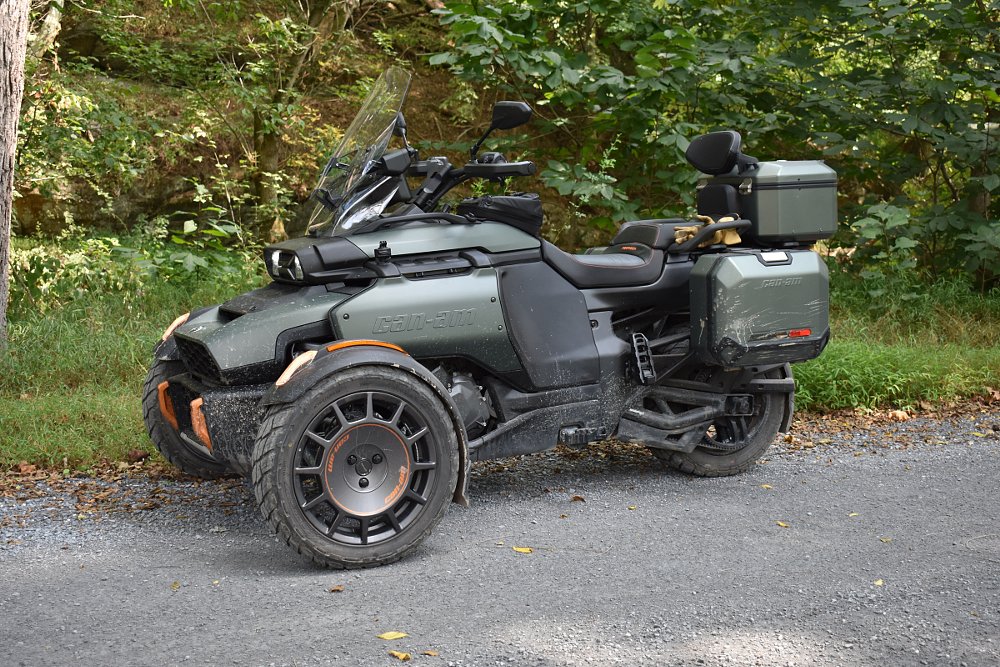
But a little knowledge and a little more practice transforms that initial surprise into a whole set of new skills. Once one has had the illumination that, when riding a Canyon, throttle solves nearly everything, starting with managing body roll, then you're on your way to Canyon Pilot Mastery. The other little lesson is that the Canyon adds its own entries to the motorcycle sidecar's contribution to the book of odd three-wheeled vehicle dynamics. In a straight line, the Canyon is a three-wheeled vehicle. In corners, the Canyon is effectively a two-wheeled vehicle, as the weight transfer of body roll weights the outside wheel, and simultaneously unweights the inside wheel – there’s a traction pie that gets dynamically distributed between the two front wheels. And the harder you go, the more downforce/traction you have on the outside wheel, and the less the inside one has to contribute.
Moving from macadam to what is supposed to be the Canyon's natural environment, gravel, things get more interesting. One is certainly not going to lose the Canyon's front end in a rutted or slippery corner like your adventure bike, and in fact, a little bit (OK, a lot) of elective oversteer is fun and perfectly controllable. If rear tire life on Canyons proves to be more than a tad reduced, I for one won't be shocked.
After I had enough solo miles to get comfortable, Sweet Doris and I went for a check ride, to see if both she and I were comfortable for the more grueling excursion we had planned. A few facts for folks who don't know us: We started riding together in 1985, I am an unremarkable, average-size human at five feet, eight inches tall and 185 pounds, and my partner is somewhere north of a few inches taller than me and (phrased in the interest of continued relationship happiness) carries some additional mass that is proportionate with her height. Folks who spend a lot of time carrying a pillion passenger will no doubt be aware of the quality of communications and coordination required to safely carry someone who is larger than yourself.
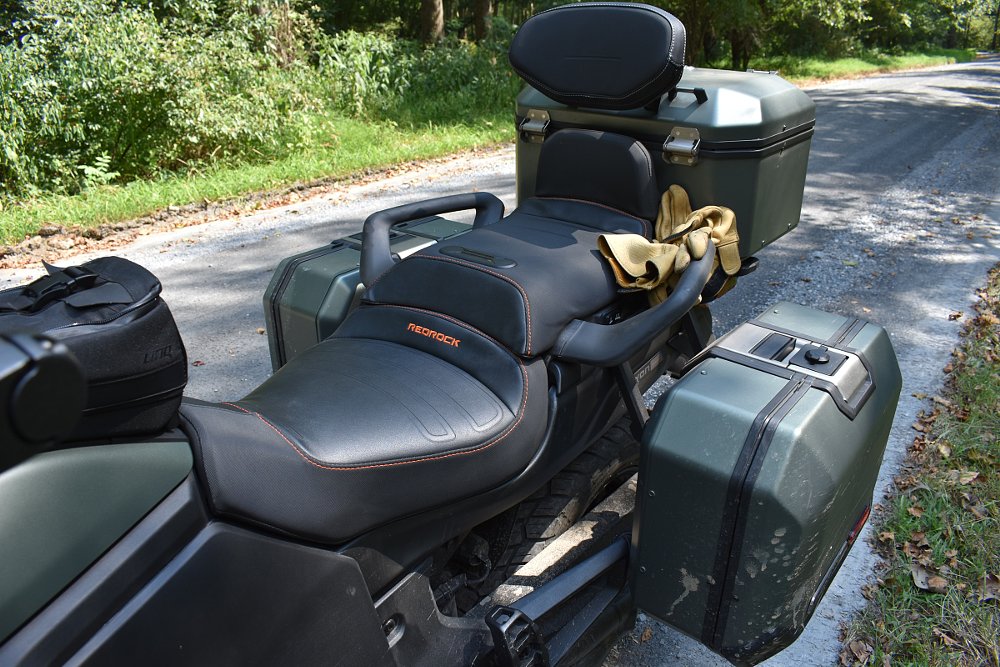
Out on the road, though, the Redrock's high-end suspension simply made its automatic adjustments to rear preload and damping, and carried on as if nothing had changed. Can-Am also gets props for the very substantial passenger grab bars, which are very useful, given the three-wheeled platform's ability to create cornering Gs. We did a roughly 30-mile loop around the county, finishing off on some of the dirt farm roads closest to home. The verdict was that our pillion was perfectly comfortable back there, except for the lack of some upper back support, and was "Green!" for the much tougher ride up into Allegheny County. A quick e-mail to Can-Am identified a topcase-mounted backrest, and they had it available for me to pick up at a local dealer the next business day. A quick session with my Bosch rechargeable drill resulted in four new holes in the aluminum case and a whole lot better support and lateral positioning for my pillion. It was go time.
Time for the two-up adventure triking expedition
Day T-minus-one saw us packing gear. A two-man tent, sleeping pads, and summer bedding all fit in the top case, while changes of clothing, some rudimental camping food and camp cooking gear, and a few vacuum growlers of drinking water and a water filter fit in the side cases. Lightweight camp chairs were strapped securely to the topcase's built-in lashing points.
We were ready for launch.
Until we weren't.
Standing in the driveway at nine the next morning provided ample evidence that the day wasn't going to provide optimum camping weather. We'd already cleared 90 degrees F by our planned departure time, and even the weather forecast for our destination of Little Orleans, Maryland, which has an additional 1,000 feet of elevation, was showing a predicted high of 97 that day. Now some desert dwellers will opine that 97 degrees isn't really hot — and maybe at 12% nominal relative humidity it isn't — but this is Maryland, baby, and we were looking at something closer to 85% humidity, and trust me, that's unspeakably hot. It wasn't going to any kind of fun to spend the night under ripstop.
So, being nothing if not flexible, the overnight trip became a day trip. The tent, bedrolls, and most of the clothes came out. The kitchen and hot meal ingredients came out. A nice picnic lunch and some fruit and other snacks went into a soft cooler in one side case. And as many additional vacuum growlers filled with cold water as would fit went in. That would prove to be a most excellent decision.
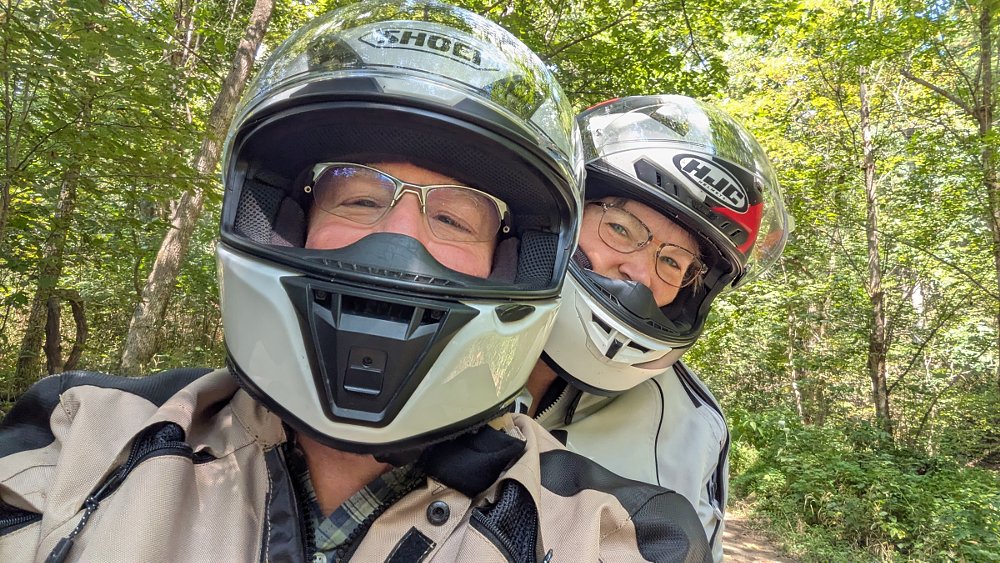
The ride to Green Ridge is a pretty spectacular one, regardless of the number of wheels beneath you. Maryland Route 17 is a lovely winding country road, and on this bit of modern pavement, the Canyon handles like it's glued down. When trying to describe the technique involved to other cyclists, my guidance is that one needs to learn to "counter-countersteer." Instead of putting pressure on the right hand grip to go right, as one does on one's motorcycle, one puts pressure on the left bar to go right. Finding the amount of effort required to keep the intended cornering line is another one of those new skills, but once you find that equilibrium and it starts to make sense, the necessary muscle memory starts to form.
Route 17 connected us to Interstate 70, which climbs over South Mountain and then makes a roughly 50-mile run into the mountains of western Maryland. The big Rotax triple never lacks for power at any road speed, but 70 to 75 mph seemed like its happy place, so that's where we stayed. I was able to use the Canyon's cool windshield adjuster — height and rake adjust using a knob that sits on the left side of the shield — to minimize the buffeting my head was taking in the windstream. At cruise on the Interstate, I couldn't help but notice that the Canyon seemed to be more sensitive to the wakes left by tractor-trailers than any roadgoing motorcycle I've ridden and being alongside one was not an improvement. Let's just say that the quest for clean air had me more motivated to pass than my customary riding base state.
A few miles past Hancock, I-68 splits off for its run across the mountains of Western Maryland’s Allegheny and Garrett Counties and out into West Virginia. I-68 is one of the jewels of the Interstate Highway System. It starts by running through the Sideling Hill Cut, a spectacular example of a geologic feature called a syncline, where the layers of underlying rock are folded into a "U" shape. Having been on the road for an hour already, we stopped to take in the vista from the top, and for some hydration. From there, it was a brief blast thought the grades and sweepers on 68 up to Little Orleans, Maryland, and the entrance to the Green Ridge State Forest.
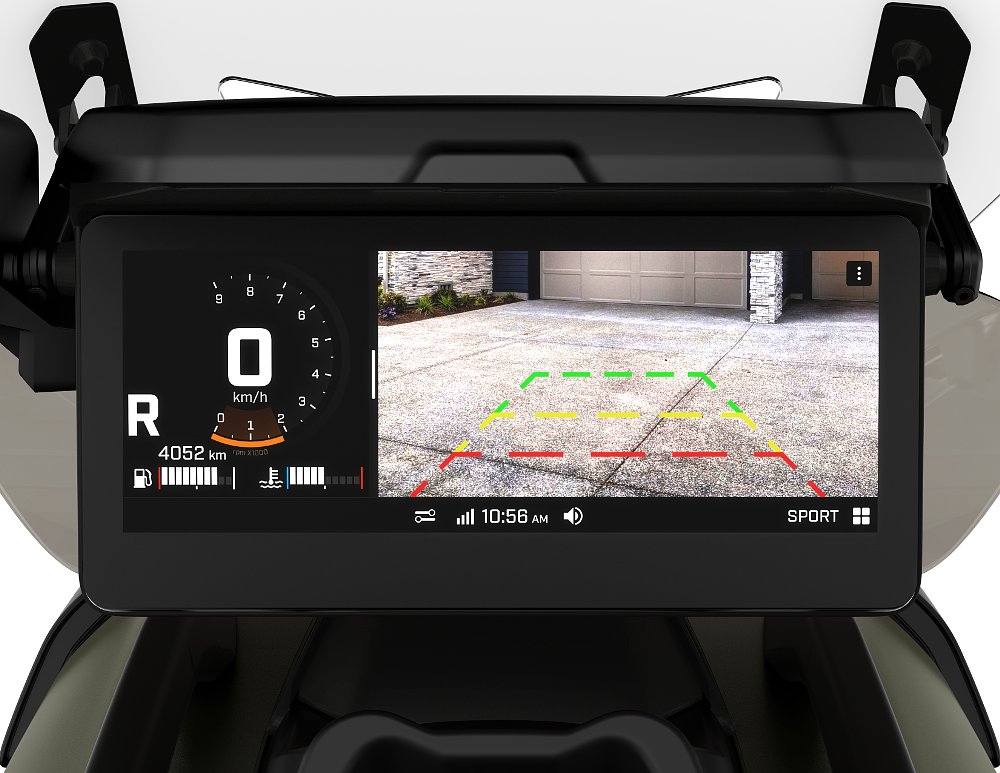
Orleans Road takes one through a rollicking country ride from the Interstate down to the state forest. Past the regionally infamous Bill's Place — which hosts an annual and more than slightly rowdy motorcycle rally — we made the right onto Oldtown Orleans Road. OO Road serves as the unpaved main drag of the 49,000 acres which make up the largest block of public land in the state of Maryland. OO has all the off-road surfaces: gravel, hardpack, and a type of washboard made by running over the edges of layers of underlying stone where they break the surface. Most of my rides on Oldtown are pretty conservative. On the Canyon, though, letting it all hang out seemed appropriate. We were still doing those little drifts coming out of corners and gassing it hard and spinning the rear wheel climbing grades.
I was waiting to hear shrieks of concern from the pillion position, but all I was hearing from back there were enthusiastic whoops that instructed me to bang on.
After a few miles of rolling country, we came to the turnoff for Mertens Avenue, which is one of several roads that descend from the ridgeline down to the basin of the Potomac River. I should note that Mertens Avenue is the most inappropriate sounding title ever for what is a glorified Jeep trail. Mertens, as I expected, turned out to be where the real challenging stuff began. Sections that hung off the side of finger ridges with unprotected drops of several hundred feet to the forest below. Stretches where the surface was made up of loose bits of sandstone that had fractured off the layers below. Rutted baby-head rock sections. You name it. On an off-road motorcycle, it's a dance to keep your line clean and to stay away from the worst-looking stuff. On the Canyon, with its three separate wheel tracks, that kind of thinking is hopeless. You just have to be satisfied to stay on the throttle and smash everything in your path.
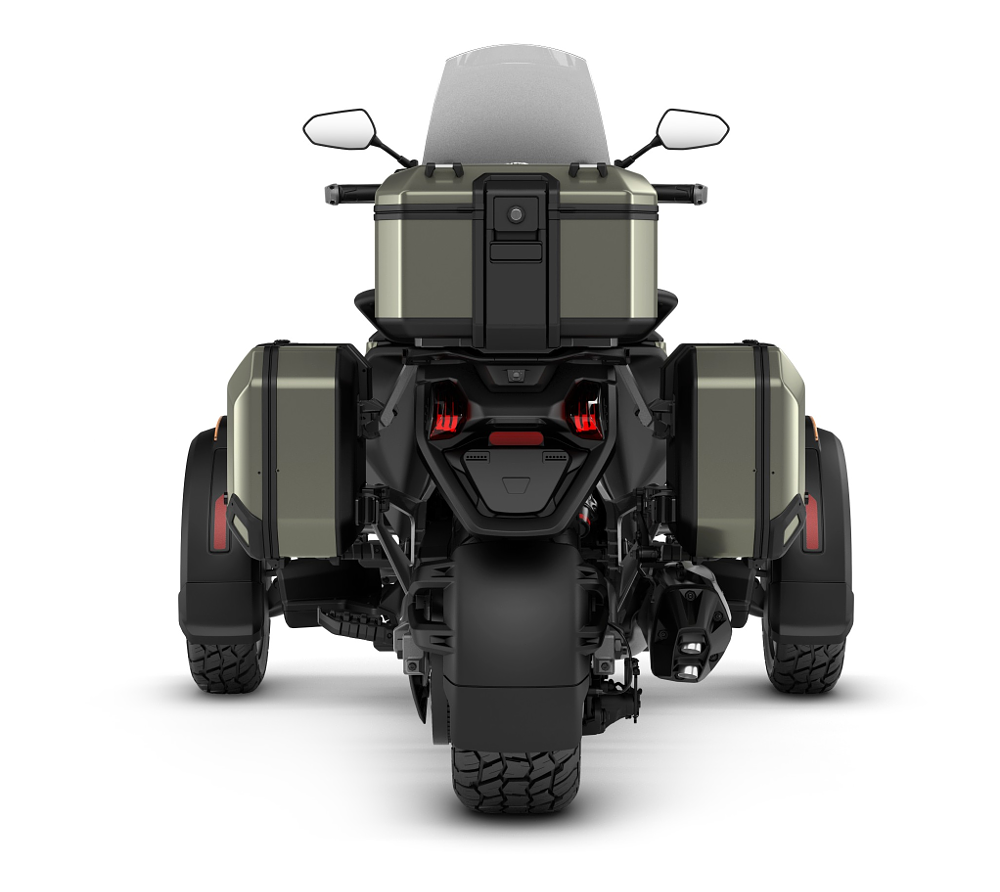
We worked our way down off the ridge, into deeper and deeper forest shade, and less and less friendly surfaces. Except for some of the tighter switchbacks, where the Canyon tended to slide its front wheels down off-camber surfaces, the big fella just sucked everything up. We'd hoped that the deeper forest would bring some relief from the heat, but our hope was not fulfilled. Just how awful the conditions were was highlighted by the fact that I hadn't seen another bike or ATV or vehicle of any kind since we'd gone past the parking lot at Bill's. Then, on a straighter stretch of Mertens, we encountered a fully farkled Jeep guy — lift kit, roll cage, high intake snorkel, winch, tractor jack, recovery boards, light bars — who had to position himself right up against the rise next to the road so we could squeeze by. I took a look at him as we passed, and the wide-eyed look on his face trying to figure out what we were riding out there was a highlight of our day.
I suspect we scarred him for life.
He was the only other vehicle or person we'd see until we left the park.
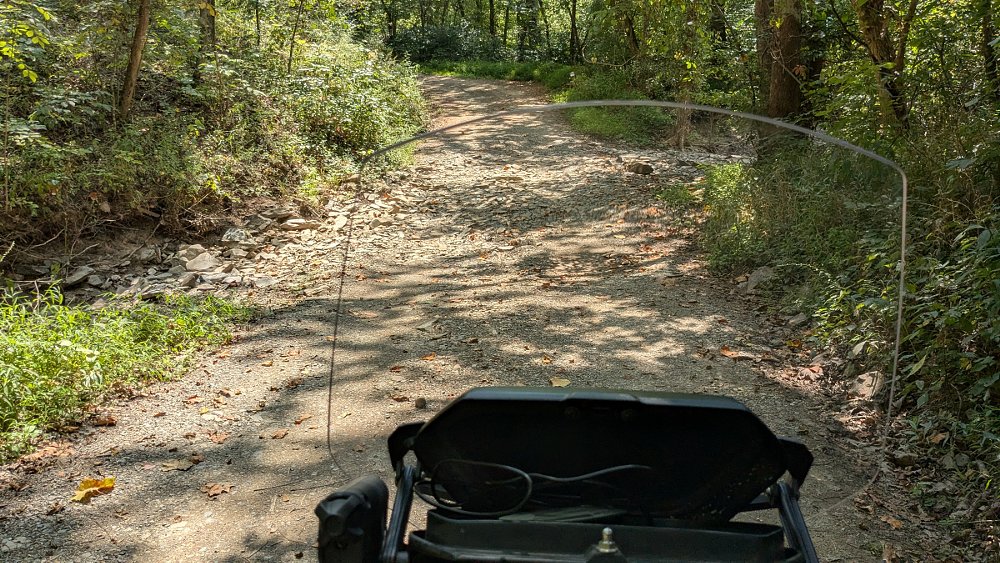
After completing our descent, we came to the intersection with Kasecamp Road, clearly identifiable from the brown CCC-vintage signs where the trails met. Kasecamp runs just above the level defined by the river and the C&O Canal, as is darker, wetter, and defined by a nearly infinite number of mud-filled chuckholes and a few dry streambeds — dry only because of the extended drought though which we had been suffering. After a thunderstorm, this would be a far different kind of ride. Seeing that the weather report for the afternoon contained a strong possibility of same, we’d do our best not to be here when it happened.
After being thoroughly decorated by the mud from those chuckholes, and a few more dry creekbed crossings without touching anything hard down, we came to the entry to the Bonds Landing campground. Sweet Doris had been wanting to see this place since I'd made the trip previously on a Cake electric enduro motorcycle, and after much plotting and scheming, the Canyon had finally got her there. Bonds is a 10-site primitive campground with the C&O Canal on one side and the Potomac River on the other three. As soon as I killed the Canyon's engine, we were surrounded by silence. We were the only ones there, and likely the only humans for miles.
We shed our gear as quickly as possible, drained one of our water bottles, and found a shady spot for lunch.
"The suspension on this thing is amazing," said Sweet Doris. "With all of the holes and bumps you took us over, I really only felt one that hit the rear wheel straight on. Everything else it just vaporized. This thing is pretty cool. Except for the maybe the amount of mud it has us wearing."
Welcome to the Adventure Riders Club, girlie.
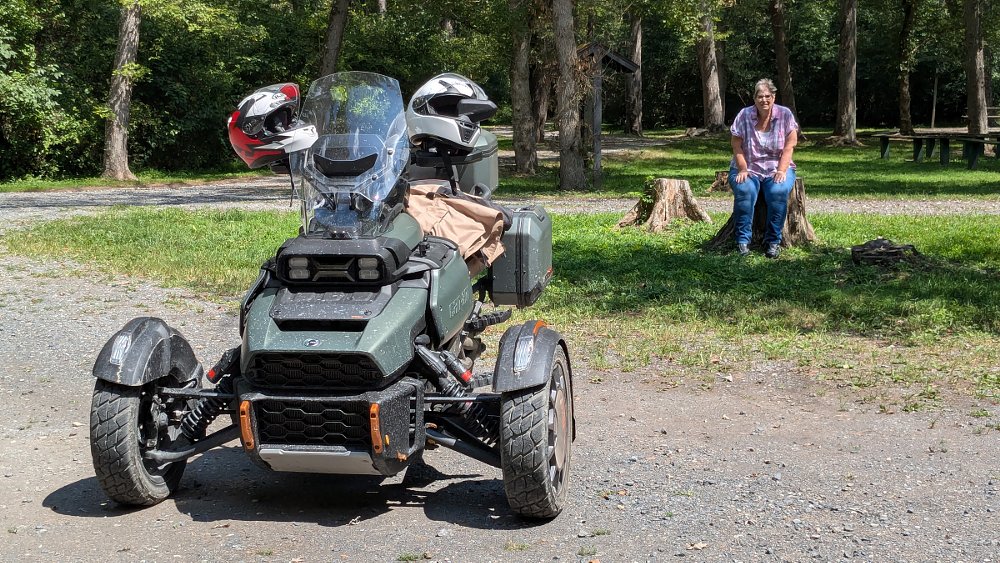
After a meal of almond butter sandwiches, apples, and cheese, and a brief period of forest meditation — listening to nothing but insects and birdsong — we determined that the only way to catch a breeze was to make our own, so we geared back up for the climb to the top of the ridge.
One of Greg's Rules for Off-Pavement Riding is that (except for extreme cases) climbing grades is always less sketchy than descending them. The Canyon conforms to this loose guideline. In fact, the Canyon seems genuinely happy with its rear wheel spitting out stones and its front wheels gobbling up uneven trail. The tunnel of green on this trail was less than perfect only in that it looked to be cooler than it actually was, but for two people far off the beaten track sharing a single machine, this ride was as comfortable and controlled as anyone could reasonably request.
I did find myself slowing down for the tighter corners, just to be fully confident of keeping all three wheels on the trail, and was happy to be going slowly when one corner exit near the top revealed a downed tree that some other rider had helpfully cleared just enough of to allow the Canyon through. This was good, as I hadn’t packed the micro chainsaw I usually bring when camping.
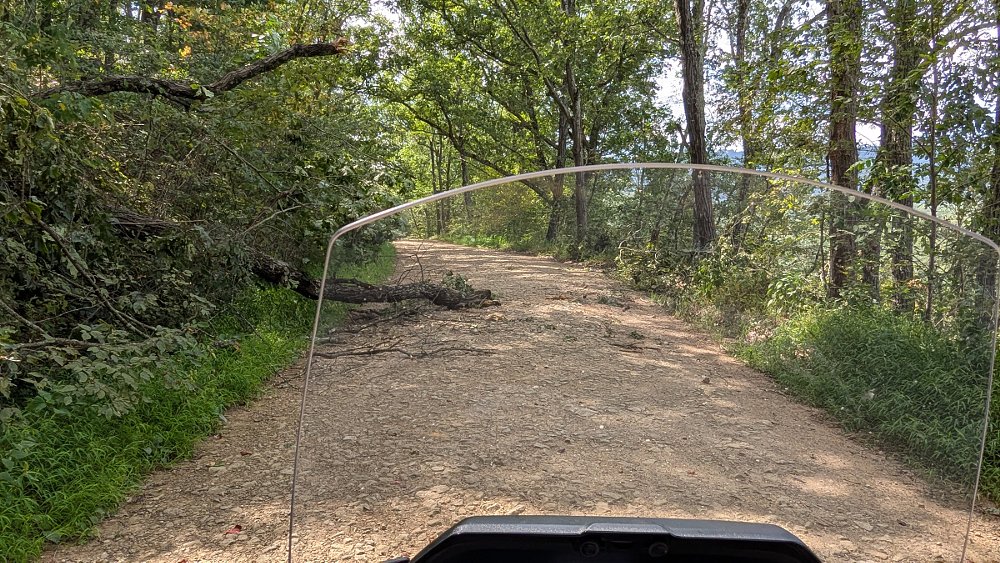
Upon regaining the top of the ridge, I improvised, continuing westward down OO Road towards Oldtown, Maryland, a major stop on the old C&O Canal. This move would keep us from having to backtrack and give us a few more off-macadam miles before having to slab back towards home. This stretch of Oldtown Orleans Road seems like Canyon country — sightlines are good, surface isn't unspeakable, and it strings together a whole bunch of small grades and sweeping corners. Sweet Doris and I kept kicking up dust and sliding through corners until we came back to the pavement just outside of Oldtown.
We ended up with a longer route back to the highway than I'd bargained for, travelling through farms outside Cumberland that are some of the oldest in the state, with roads that were nearly as old, laid out in the late 1700s to early 1800s. This is where the Canyon became a handful. These pre-highway-code antique roads can have high crowns, steep and off-camber grading, and really random, winding paths that leave the Canyon's two front wheels sitting at different levels, and I didn't find that particularly relaxing. Perhaps a more experienced Spyder pilot might have managed it better, or felt more comfortable with the behavior of the machine, but I simply didn't have the saddle time necessary for that.
After 30 or so miles of goat path, we finally came to Flintstone, Maryland –— so named for an old quarrying operation, and not for Fred — and back to I-68. Sweet Doris called for a rest stop, as the heat was really getting to both of us, and 50 or 60 miles of Interstate, with nearly 100-degree air flowing over our bodies, was not going to make that any better. There isn’t a great deal of stuff in Flintstone, anymore, but the largest building is a very stately old white Methodist church, with a very large tree and picnic pavilion in its back yard. I aimed the Canyon for the massive spot of shade under that tree. We shed our gear, drained another bottle of cool water, and took the briefest of naps, then saddled back up and headed east on I-68.
After 215 miles of wandering and adventuring, we made it back to our air conditioning and some cold showers. That night we slept like the dead.
So, are adventure trikes the future of off-road riding?
Not for everyone, but for some people they absolutely are.
If you're looking to share your backcountry rides with someone who wants or needs to be a passenger, the Can-Am Canyon will take both of you (and your gear) on any kind of road or two-track you'd like to explore. And you’re not going to run into a lot of other people doing the same out there.
Even if you’re not planning to bring a buddy with you, there are other reasons an adventure ride might be enabled by the Canyon’s three-wheeled platform. The most committed Can-Am Spyder rider I see on the roads near my home is a female U.S. Marine veteran of the Iraq campaign who has a prosthetic leg. Motorcyclists who have been injured as the result of road or competition accidents may also want to return to two wheels but may not be able to. Riders get older and knees, backs, and hands are all prone to inconveniently wearing out. Can you hold up, or worse still, pick up a dropped, loaded BMW R 1300 GS?
The Canyon allows all of these riders — given its simpler control layout and more stable three-wheeled platform — to get out and enjoy riding in the back country.
Take it from Ari and Zack, though. Try to stay off the Black Diamond trails.
| 2025 Can-Am Canyon Redrock | |
|---|---|
| Price (MSRP) | $32,299 base |
| Engine | 1,330 cc, liquid-cooled, 12-valve, inline-three-cylinder |
|
Transmission, final drive |
Six-speed semi-automatic, belt |
| Claimed horsepower | 115 @ 7,250 rpm |
| Claimed torque | 96 foot-pounds @ 5,000 rpm |
| Frame | type |
| Front suspension | Double A-arms, KYB Smart Shox; 10.2 inches of travel |
| Rear suspension | KYB Smart Shox, self-leveling air preload adjustment; 9.2 inches of travel |
| Front brake | Brembo four-piston calipers, 270 mm discs with ABS |
| Rear brake | Single-piston caliper, 270 mm disc with ABS and integrated parking brake |
| Wheelbase | 67.6 inches |
| Ground clearance | 6.3 inches |
| Seat height | 33.2 inches |
| Fuel capacity | 7.1 gallons |
| Tires | XPS Adventure, K155/65R16 front, 225/50R15 rear |
| Claimed weight | 1,036 pounds dry |
| Available | Now |
| Warranty | 24 months |
| More info | can-am.brp.com |




